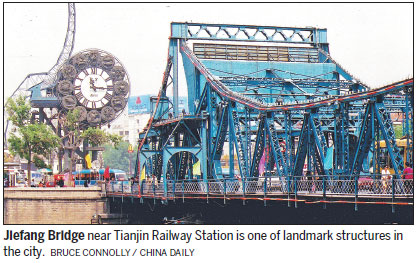A municipality worthy of many return visits
Travel and photography, particularly in China, have long been my passion. In the beginning, it was often the case of dashing around the country, shooting images of everything that was new to me before heading off to somewhere else and again taking photographs. That was when visits were limited by available holiday time from my native Scotland. Such experiences, although exciting, were often frustrating for I would depart with a feeling there was so much more to be gained. Now living in China, I find myself regularly returning to places that have fascinated me, taking time to discover more of the history, the different periods in time represented by architecture or maybe just surviving street names. Although appearing increasingly modern, China's cities have many layers to them going back sometimes thousands of years. Despite physical change, often a colorful human side has been retained - a street life just waiting to be photographed.
Tianjin is one such city which I first experienced briefly in 1996. Only 30 minutes from Beijing by high-speed train, because of its geography and a history influenced by both maritime and canal trade, it presents a quite different image to the photographer. Following on from four visits last year, I was invited back this April for an appearance on the television show Vivian Speaking to talk about my experiences and feelings about the city. Staying on for nine days, it proved to be another journey of discovery.
The Haihe River flowing southwards through central Tianjin has long been at the heart of the city's identity and growth. Walking along its manicured banks or sitting at a riverside park overlooking one of the two sweeping meanders within the downtown area, it is hard today to imagine the bustle that went on for centuries at this very location - a scene enhanced by the futuristic, cubic shaped St. Regis Hotel. Its eye-catching architectural design incorporates "Jinmen" or "Tianjin Gate" for the city over many centuries was indeed a gate, a gateway from the sea to landlocked Beijing and northern China. "Haihe" literally translates as "Sea River" referring to a relatively short stretch of water running from where the Ziya River merged with the Nanyunhe, the southern stretch of the Grand Canal close to Jingang Bridge. The Haihe River flows outwards to Tanggu before discharging into the Bohai Gulf alongside Tianjin's vast modern port, one of China's busiest.
The early city centered on the Drum Tower (Gulou) just south of the Grand Canal and was compact, walled and laid out, as was the pattern in many early Chinese settlements, on a strict geographical north, south, east and west layout. Although the walls have gone, the heart of the old city can still be traced. Although it is commonly thought the name Tianjin was given to the city by Ming Dynasty Emperor Yongle, there is also a view it referred to its waters being a gateway or route to Beijing where the word "Tian" or "Heaven" had long associations with past emperors.
Throughout history the city has been an important trading and transhipment center. The Haihe River is relatively shallow and prone to silting. Larger sea-going vessels anchor at Tanggu Port with cargoes transferred by smaller vessels and barges upriver to Tianjin, with much going onwards along the northern extension of the Grand Canal to Beijing. Certainly the formerly muddy banks were once crowded by small vessels being loaded or unloaded by armies of porters with wooden shoulder poles. Horse-hauled carts would transfer the cargoes to warehouses for onward transportation.
Commerce bustled along its "bund" similar in some ways to Shanghai, but the shallowness of the waters means that today only sightseeing tourist boats cruise day and night along with the occasional fishing craft. However, some of Tianjin's contemporary charm, its attraction, comes from the landscaping of several kilometers of river banks today lined with often futuristic, indeed striking architecture. It is particularly beautiful at night when buildings and bridges are illuminated.
One of China's earliest railways connected the early Tanggu Port with today's downtown area. Today Tianjin is a nodal point on the nation's rail network where lines from the northeast join others radiating both south, west and of course, north to Beijing. High-speed trains today serve these routes.
Unique historic districts encourage visitors and photographers to Tianjin. I have walked the area many times thinking of its legacy while trying to imagine the scene over one hundred years ago. However, this time I was invited to join a walk organized through the city's American Chamber of Commerce. For me a journey of discovery, learning and seeing much more about what I had thought was familiar.
It was interesting sensing the passion among the group - some were Tianjin locals while others were westerners living and working in the city, but all shared a mutual feeling for Tianjin.

(China Daily 09/18/2018 page18)














